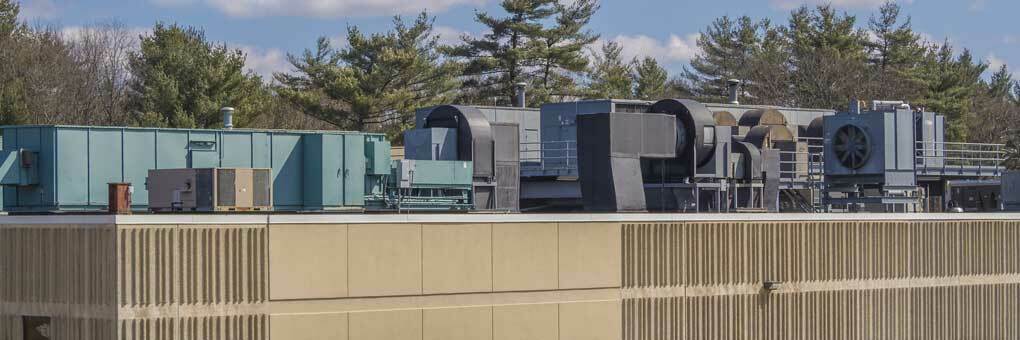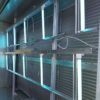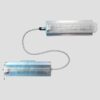Facililties Served

The Trusted Authority for Energy Efficiency
Energy Efficiency and Decarbonization Benefits
How Lumalier’s in-AHU UVC contributes to decarbonization and energy efficiency:
- Keeps coils clean 24/7/365.
- Restores Delta-T and thermal efficiency, improves air flow, reduces static pressure and fan amperage to achieve 12%-20% energy cost reduction/3 to 5 year energy ROI.
- Reduces CO2. Annual KWH savings/1425 = metric ton reduction of CO2.
- Generates greater condensate volume to lower Relative Humidity (RH%) in the facility.
- Reduces outside air; UVC Air treatment = 8 to 20 additional Air Change/Hour equivalency (ACHe)
Problem: To truly keep coils clean and performing to original specifications, coils may need to be cleaned 4 times per year (quarterly)– which is expensive, labor and chemical intensive, and unrealistic.
Solution: Lumalier's in-duct UVC is specifically engineered for the ideal treatment of coils, engineered and scaled specifically for the coil’s exact height, width, and CFM of the HVAC system.
Background: Biofilm naturally accumulates on all cooling coil fins, reducing thermal energy transfer and air volume, while increasing static pressure and air speed (less contact time with cooling fins); Biofilm also serves as the ‘glue’ that attracts and holds particulates that bypass filtration, causing coil fouling and efficiencies to decline rapidly. Biofilm causes all AHU components to work harder, including chiller plants and fan motors.
ASHRAE states: “Damp coil and drain pan conditions are excellent forums for growth of bacteria and mold (biofilm). Coil fouling caused by growth of bacteria and mold increases coil pressure drop and reduces airflow, reducing heat transfer from coil fins to lessen the amount of work a system can perform.”
ASHRAE Handbook, Chapter 16, 2008; Chapter 60, 2011 & 2015.
Facility managers are often forced to compensate for cooling capacity loss by reducing chilled water temperature, increasing fan speeds, lowering thermostats, and adjusting set backs; reactive efforts that greatly contribute to increased energy consumption.
The ECO Solution (Environmental Coil Optimization)
“UVC can be readily applied to HVAC systems to keep coils, drain pans, and other surfaces clean and free of microbial contamination. UVC maintains heat exchange efficiency, design airflow, and improves indoor air quality by reducing bacteria and mold growth on system components.” “Coil pressure drop is reduced and, therefore, airflow is restored. Because heat transfer also is restored, this combination can result in significant energy savings, with payback of possibly less than 2 years.” ASHRAE Handbook, 2008, 2011, 2015
Environmental Coil Optimization destroys the insulating biofilm to ‘release’ dirt and debris that contribute to coil fouling. Coil optimization returns the AHU to as-new specification to help achieve the benefits listed by ASHRAE, while providing substantial and immediate energy efficiency that results in rapid ROI payback.
Jurisdictions globally are confronting climate change and recognizing that building decarbonization is an important component in their efforts.
The worldwide building sector accounts for about 40% of energy-related carbon emissions and buildings remain a major sector that lacks sufficient mitigation policies.*
*Source: https://www.ashrae.org/about/a...
AHU Benefits:
- Eliminates all mold and biological growth on coil fins, drain pan, fan motor and surrounding plenum, and odors are eliminated.
- Bio-free coils generate greater condensate volume and lower Relative Humidity (RH%) in the facility. Increased condensate properly removes debris as originally specified = cleaner coils and cleaner pans.
- Delta-T and thermal efficiency restoration, static pressure reduction, improved air flow, reduced fan amperage draw = return to as-built specifications.
- Energy savings = 8% to 20% / energy ROI = 1 to 4 years.
- Keeps coils clean 24/7/365
Maintenance Benefits:
- Eliminates need for chemical coil cleaning = labor and chemical savings.
- Eliminates need for pan pills or odor pills in pans or plenums.
- More Efficient system = fewer service issues.
- Lifecycle of AHU extended by ~ two years.
UVC for IAQ and Energy Efficiency
In AHU & In Duct UV Fixtures
In AHU & In Duct UV fixtures, such as the Lumalier AR Series UVC Fixtures, are installed inside ventilation systems to provide high-level, facility-wide disinfection of the airborne infectious pathogens that can cause respiratory sickness, disease, and infection. In AHU & In Duct fixtures are scalable to fit any size air handler unit (AHU).
- Eliminates biological growth on coils and in the drain pan that can cause coil fouling, odors, and premature failure of air conditioning equipment.
- Provides an ROI benefit with reduced energy consumption and maintenance.
- Achieves the greatest square foot coverage at the lowest cost.
- Uses the existing ventilation system to disinfect and distribute air.
UVC for IAQ
Upper-Air UV Fixtures
Upper-air UV fixtures are engineered to provide very targeted airborne pathogen reduction in high-risk areas. Pathogen reduction can lead to ACHe benefits and can allow building owners to reduce air changes.
- Installation applications include healthcare, office buildings, universities, K-12 schools, correctional facilities, food manufacturing, etc.
- Units are available for high or low ceilings and for any square footage.
- Units can be permanently or temporarily installed for flexible space uses.
- Natural convection-currents create repeated air disinfection within defined spaces. Fan assisted models are available.



